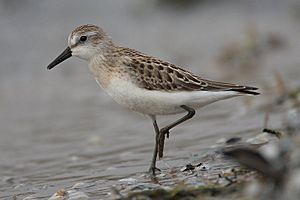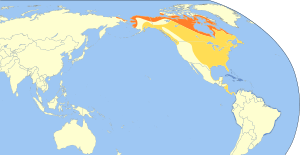Semipalmated sandpiper facts for kids
Quick facts for kids Semipalmated sandpiper |
|
|---|---|
 |
|
| Conservation status | |
| Scientific classification | |
 |
|
| Synonyms | |
|
The semipalmated sandpiper (Calidris pusilla) is a very small shorebird. It gets its name "semipalmated" because its front toes are partly webbed, like a duck's foot. This helps it walk on soft mud. These birds are sometimes called "peeps" because they are so tiny.
Contents
What Does a Semipalmated Sandpiper Look Like?
This sandpiper is a small bird, usually about 13 to 15 centimeters (5.1 to 5.9 inches) long. It weighs around 20 to 32 grams (0.7 to 1.1 ounces), which is about as much as a few quarters! Its wings can spread out to about 35 to 37 centimeters (13.8 to 14.6 inches).
Adult semipalmated sandpipers have black legs and a short, dark bill that is straight. Their bodies are dark grey-brown on top and white underneath. Their head and neck have a light grey-brown color. It can be tricky to tell this bird apart from other small shorebirds, especially the western sandpiper.
Where Do Semipalmated Sandpipers Live and Breed?
Semipalmated sandpipers breed in the southern tundra regions of Canada and Alaska. They like to be near water. These birds build their nests on the ground. The male sandpiper digs several shallow spots, and the female chooses the best one. She then adds grass and other materials to make a cozy nest.
The female usually lays four eggs. Both the male and female take turns sitting on the eggs to keep them warm, a process called incubation. After the chicks hatch, the female often leaves them with the male. The young birds are able to find their own food very soon after hatching.
What Do Semipalmated Sandpipers Eat?
These birds look for food on muddy areas near water, called mudflats. They use their eyes to spot food and also feel for it with their bills in the mud. Their main diet includes small aquatic insects and tiny crustaceans, which are like small shrimp or crabs.
Migration and Conservation Status
Semipalmated sandpipers are amazing long-distance migrants. This means they travel very far between their breeding grounds and their winter homes. They spend the winter along the coasts of South America, and some also go to the southern United States and the Caribbean.
They travel in huge flocks that can have hundreds of thousands of birds! They often stop at special feeding spots during their journey, like the Bay of Fundy and Delaware Bay. Sometimes, a few of these birds might even fly off course and end up in western Europe, which is quite rare.
Even though there are many semipalmated sandpipers, they depend a lot on a few key places to rest and eat during their long migration. Places like Mary's Point and Johnson's Mills in Shepody Bay (part of the Bay of Fundy) are very important for their survival. The conservation status of the semipalmated sandpiper is "Near Threatened," which means their populations are decreasing and they could become endangered if we don't protect their habitats.
Images for kids
See also
 In Spanish: Correlimos semipalmeado para niños
In Spanish: Correlimos semipalmeado para niños



